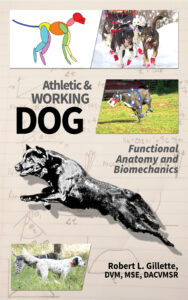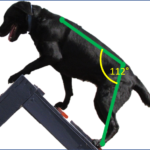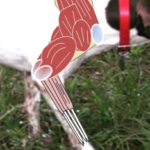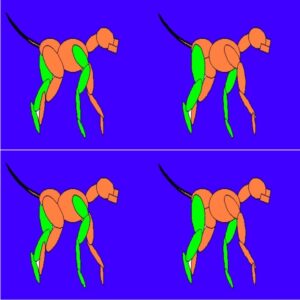Description

Applied Biomechanics for the Performance Dog
Just over 55 minutes in length | Already Enrolled? CLICK HERE
Biomechanics is the study of the mechanics of biological activity. It can be used by the an owner, trainer, handler or Veterinarian to optimize, improve, enhance canine performance or diagnose performance issues. Biomechanics and its application to athletic or work performance is called Kinesiology. Kinesiology is the study of human and animal movement, performance, and function. It is made up kinematics and kinetics. Kinematics is the branch that studies the geometry of motion. It describes motion in terms of how far something moves (e.g. stride length), how fast something moves (e.g. speed), how long something moves (e.g. stride time), and how consistently something moves (e.g. stride rate). The motion described may be linear (in a straight line) or angular (in a circular path). Kinetics is the branch that studies the forces of movement. It describes the causes of motion, or the forces involved. Static states are where all of the forces are balanced and the body is in equilibrium. Dynamic states are where the forces are not balanced and the body changes or moves in relation to the resulting force variance. This information is helpful when describing or communicating about how a dog moves. It can be used to establish normal movement parameters, identify movement alterations or to determine optimal movement patterns related to activity or performance.
It is the intent of this course to introduce the applications of Kinesiology (Biomechanics) to the student in a functional manner. This is very helpful when the professional is developing a training regimen, conditioning program, identifying performance deficiencies, or making decisions related to a rehabilitative program.
Course Presentation Handout
There is a copy of the presentation used for this course available to download. The handout can be found by clicking on the Materials tab above. Then click on the link after “Click this link to view presentation handout:”. It is only available to those who have enrolled in the course.
Applied Biomechanics Lessons
Lesson 1 provides an introduction to Kinesiology Terms, Force Definitions and Surface Impact forces. Video is just over 5 1/2 minutes long.
Lesson 2 discusses Comparative Biomechanics, the Anatomical Segments, the Center of Mass and the Step Cycle of the Dog. Video is just over 7 minutes long.
Lesson 3 discusses ways to measure the forces created by, and affecting the body. Some force measuring systems described here include the Force Plate, EMG and Pressure Mats. Video is just under 5 1/2 minutes long.
Lesson 4 introduces the subject of Kinematic Analysis and discusses both Subjective (qualitative) and Quantitative ways to assess movement. It further discusses Strides, Gaits, Linear & Angular measurements. Video is just over 12 minutes long.
Lesson 5 discusses movement measurements including Gallop, Stride Length or Time and a racing Greyhound Reference Base, The discussion includes Speed and Fatigue Factors of the Vertebral Muscles and the Loss of the Appendicular Spring. This is applicable to all dogs. Video is just under 8 minutes long.
Lesson 6 is a discussion of the Forces of Activity and a summary Applied Biomechanics. Video is just under 17 minutes long.
Suggested Text for this course: Athletic and Working Dog: Functional Anatomy and Biomechanics, Robert L. Gillette, RMG Enterprises, Incorporated, 2019, ISBN: 978-1733024419

The Athletic and Working Dog: Functional Anatomy and Biomechanics



